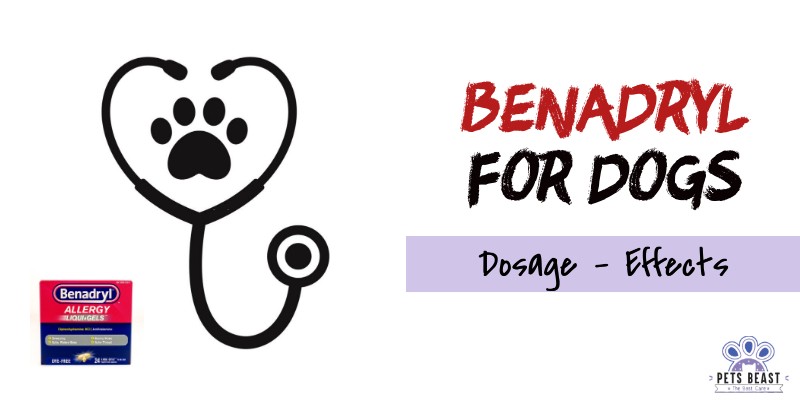Important Note: Before giving your dog medicine, it is best to consult experts especially your dog’s veterinarian.
Benadryl is one of the most popular medicines for people. Its medical name is diphenhydramine and is a common medicine used for human allergy. One fact that a lot of people don’t know is that Benadryl can also be used on dogs.

In cases like insect bites or anxiety, Benadryl can relieve the symptoms being experienced by your lovely puppy or doggie. But before you use one on your dog, it is best to know the important facts about this medicine. Most importantly, there are cases when you must not give Benadryl to your dog. This is also discussed below.
Can I Give Benadryl to My Dog?
Yes. You can give Benadryl to your dog. It is not a medicine exclusive to humans. Veterinarians allow the use of this over-the-counter medicine to alleviate your dog’s motion sickness, allergic conditions due to insect bites, or to relieve its seasonal allergies. Jessica Vogelsang, PetMD’s Doctor of Veterinary Medicine, gives assurance that Benadryl is tolerated and has a significant safety margin for usage on dogs.
What is Benadryl for?
Specifically, the following are the uses of Benadryl in dogs:
- Relief of allergic reactions such as inflammation, headaches, watery eyes, sneezing, and itching
- Relief of insect stings and bites
- Treatment of nausea and motion sickness
- Relieves anxiety
How Much Benadryl Can I Give My Dog?
The amount of Benadryl that you can give to your dog depends on its weight. The recommended dosage is 1 milligram of Benadryl for one pound of body weight. Since most over-the-counter Benadryl tablets are available at 25 milligrams, one tablet is enough for your 25-pound dog. Veterinarians recommend giving one dose of Benadryl every 8 to 12 hours to your dog. Hence, 2 to 3 times a day.
Meanwhile, small dogs weighing less than 25 pounds can take children’s formula of liquid Benadryl. The same dosage applies but it is easier to measure here because of the medicine’s measuring cup.
On an important note, make sure to not give too much Benadryl to your dog or else, it can lead to overdose. Too much of it can result in diphenhydramine poisoning, which is fatal. Its symptoms include seizures, agitation, dilated pupils, constipation, and rapid heart rate. Hence, if you are unsure about the proper dosage of Benadryl specific to your dog, make sure to consult a veterinarian.
What Are the Side Effects of Benadryl?
Just like any other drug, Benadryl has some side effects. They include:
- Increased heart rate
- Hyperventilation
- Drowsiness
- Dry mouth
- Urinary retention
- Hypersalivation
- Loss of appetite
When is Benadryl Bad for Dogs?
There are some situations wherein vets don’t recommend the use of Benadryl own. The following are these instances:
- Your dog has these medical conditions: glaucoma, high blood pressure, or heart disease
- Your dog is under medication that must not be taken with Benadryl as it may cause a harmful reaction
- Your dog has an allergic reaction to Benadryl
- Your dog cannot handle the side effects of Benadryl including urination, rapid heart rate, and rapid breathing
- The brand of Benadryl you bought contains Pseudophedrine and Acetaminophen, both of which are substances harmful to dogs
- When your dog overdoses on Benadryl
- When your dog is either pregnant or nursing. Seek advice from your veterinarian first as to which brand of Benadryl or whatever medication can be used by your dog
Check Other Possible Causes
If you want to give Benadryl to your dog because of allergy, you might want to make some initial observations first. Certain foods you are feeding to your dog may be the cause of the allergy and continuous use of that only means that you will use Benadryl to it every time. This can be harmful to your dog since as mentioned earlier, consuming Benadryl results in various side effects.
What you should do then is to first check what you are feeding to your dog. If it is dog feed, check the contents and ingredients. Majority of the contents might be made from animal-based ingredients including chicken, beef, lamb, pork, fish, rabbit, and dairy. According to this study from the National Library of Medicine, these animal-based ingredients are 3 times more likely to cause allergy in dogs than plant-based ingredients. This might be what is happening to your dog so you might want to switch to another dog food.
To repeat, it is best to consult with your veterinarian to find out the best feed that you can give to your dog. For instance, the best organic dog foods might eliminate your dog’s allergy problems.
What are the Alternatives to Benadryl?
Fortunately for you, Benadryl is not the sole solution to your dog’s allergy problems or motion sickness. The following are some of the best alternatives to Benadryl:
Quercetin
Quercetin is also known as natural Benadryl. This compound is found in the skins of vegetables and fruits. It has anti-histamine, antioxidant, and anti-inflammatory properties.
Cannabidol
Cannabidol is another natural alternative to Benadryl. Contrary to misconceptions, Cannabidol is not derived from marijuana. According to scientific studies, this compound can relieve itchy and dry skin caused by allergy. It also has anti-motion sickness properties so this natural medicine can be a good alternative to Benadryl for your dog.
Baking Soda
If your dog’s problem is inflamed, red, and itchy skin due to allergy, you can try to use one of the most popular home remedies for all sorts of things – baking soda. You can use it either as a spray or a paste. To make a baking soda spray, put some baking soda into a spray bottle then pour water into it. Make sure that the solution is not viscous and more of watery so that you can spray it easily.
On the other hand, you can make a paste by mixing baking soda powder with a little bit of water. This time the combination must be viscous, just like dog toothpaste.
Use either of these two on your dog by applying it on the affected area.
Conclusion
Overall, Benadryl can indeed by used on your dog. It can address your dog’s allergy, motion sickness, or even anxiety. Just make sure to seek advice from your dog’s veterinarian. Don’t forget the side effects of the medicine as well as the instances wherein it is not recommended to be used. And finally, keep in mind that there are natural alternatives to Benadryl that may be just as effective (or perhaps even better) than the common medicine.







